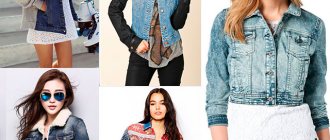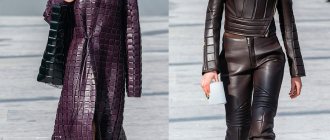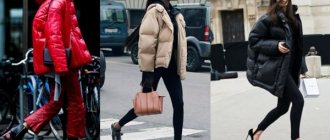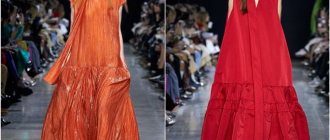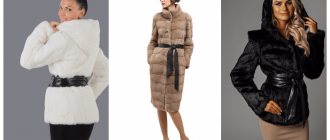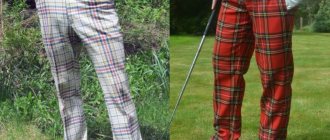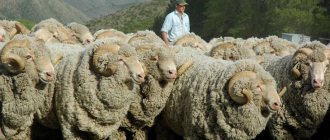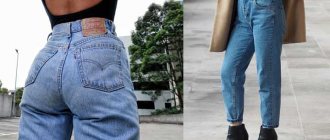Autumn will soon come with cold winds and leaden clouds, which means it's time to choose a jacket. The good news is that designers have given in and accepted it as part of street fashion. This means that lovers of casual, sport-chic, boho, grunge, classic and other styles will find outerwear to suit their taste. In this article we will talk about what fashionable jackets we will wear in the fall-winter 2021–2022.
Jacket with drawstring waist
Jacket with laces
Jacket (Eco down)
How to choose a winter jacket to stay warm
“Look how well the down jacket fits on you, warm, warm, no doubt,” the saleswoman habitually jabbers, serving another customer who has come to warm up before the harsh Siberian frosts. It’s up to you to take the word of a nice consultant or try to figure out for yourself exactly what temperature a winter jacket is designed for. In this material we will briefly look at the main insulation materials used by jacket manufacturers, from the point of view of their ability to warm the wearer in cold weather.
Fluff and feathers
It so happens that almost each of us habitually calls any winter jacket a “down jacket,” although this is only true for a certain part of the representatives of winter outerwear. Naturally, only a jacket that uses natural bird down and feathers as insulation can be called a down jacket.
Most often, eiderdown or goose down is used in outerwear. On the labels of imported manufacturers it is designated by the word down. Next to this word is feather - “feather”. The ratio of the first and second ranges from 70:30 to 85:15, the more fluff, the warmer and heavier the product.
The warmest and most expensive eider down. Such down jackets can cost several tens of thousands of rubles. The thoughtful cut of the gasket with filler also increases the price of the product. For example, to prevent the fluff from clumping inside the product and coming out, it is sewn into special bags, which are then evenly placed inside the lining. To avoid cold bridges in the seams, competent manufacturers lay bags of fluff overlapping or glue the seam spaces with special compounds. When choosing a down jacket, inspect the seams, remember the product slightly - there should be no sharp ends of feathers or down sticking out of it.
The advantage of down jackets is their high thermal insulation rates, like all natural materials. But they require especially careful care when washing or cleaning. At the same time, natural material serves as an excellent breeding ground for dust mites. It is best not to purchase low-quality down products at all, since problems during wear (feathers and down that come out and get tangled) will negate the pleasure of warmth.
Viva synthetics!
Perhaps the most common fillers for warm jackets today are synthetic. Their use is justified by ease of maintenance, relative affordability and good thermal insulation properties.
One of the most common insulation materials for outerwear is synthetic winterizer. It has a small volume and does not crumple when worn, but a jacket with padding polyester can save you from frost of a maximum of 10-15 degrees.
A more frost-resistant insulation is holofiber. It is more voluminous - products with it look plumper, which may not be to the taste of fashionistas. But the obvious advantage of holofiber is that it can easily warm the owner at temperatures up to 25-30 degrees below zero.
Recently, products based on new-generation synthetic insulation materials, such as Fibertek, Waltherm, Thinsulate, etc., have come into mass sale. All these are developments of foreign companies, which were originally used in the sewing of military and sportswear. They owe their heat-saving properties to synthetic hollow fibers that have a high degree of elasticity. Products with such fillers may not be inferior in thermal insulation properties to down jackets.
The most popular filler is Thinsulate, developed by the American company 3M. This is a very light and warm material that recovers well after washing and, despite its artificial origin, allows the body to breathe. In terms of cost, products with Thinsulate as a filler are close to jackets based on natural down.
Typically, the label of a product with a synthetic filler contains the word Polyester. This means with a 90% probability that there is padding polyester or holofiber inside. The latter, as already mentioned, is more voluminous and warm.
By the Thinsulate inscription you will unmistakably identify Thinsulate. Another modern insulation, which is most often used in sportswear, Waltherm will be designated as Valtherm. By the way, experts advise purchasing products with Waltherm with a density of at least 200-250 units for the winter.
Helpful advice
Products filled with natural down are best dry cleaned. When washing down jackets, use the gentle cycle or hand wash them without soaking or wringing. When washing by machine, experts advise putting a couple of tennis balls in the drum: they will absorb excess moisture and roll over the jacket during washing, preventing the fluff from falling off.
What does the label say?
The label of the factory product must indicate the material from which the top of the jacket is sewn, the material of the filling and lining. The outer fabric can be windproof or waterproof, which will certainly increase wearing comfort.
The abbreviation CLO and the number from 1 to 3 will indicate the thermal insulation properties of the product. Thus, a down jacket with 1CLO is designed for temperatures down to -15o C, 3CLO - up to -40o C.
In addition to the label, many large manufacturers supply their products with a special booklet, which describes in detail the properties of the filler and upper fabric.
Styles and varieties of jackets
1. The classic men's winter jacket is a jacket with a classic cut. For this reason, it is ideal for business and representative men. It is usually of medium length and is often trimmed with a fur collar.
2. Parka - a very warm winter jacket, which can additionally be insulated inside with artificial or natural fur. Its main differences from other models are, firstly, the mandatory presence of a hood, which can be with or without fur trim, and secondly, the jacket fabric is very dense and waterproof. In addition, the design of the jacket includes decorative laces, buttons, emblems and patch pockets.
3. A leather jacket is one of the warmest. After all, it is insulated with natural down or fur. However, it requires periodic care with leather care products. At the same time, this jacket looks beautiful and expensive, which emphasizes the high status of its owner.
4. Sports style jackets - mostly short and medium length. They are usually chosen for sports and outdoor activities. Special “breathable” materials are used as insulation to effectively remove excess moisture during physical activity.
5. A down jacket or Alaska jacket is the best option for a harsh winter. Since goose down, camel hair, and Thinsulate are used as insulation, these products will be the warmest. In addition, the length of such jackets is mid-thigh or lower, and the deep hood is trimmed with natural or faux fur.
When can you start wearing a women's winter jacket?
Often the moment when you can start wearing a women's winter jacket
, comes on suddenly.
The most common opinion is when the temperature drops to zero
. At this moment, the air itself becomes frosty, and if under your jacket you are dressed the same as a week ago, then winter outerwear better resists the cold’s attempts to get inside.
At first, there is no need to take out all the winter paraphernalia from the depths of the closet, like a scarf and mittens. While the weather is hovering between plus and minus, you are unlikely to freeze even without a hat.
It is worth making an exception to this, such as an icy wind. Squally and gusty, it knocks down the feeling of air temperature by several points. So watch out the window to see how windy it is outside.
before deciding how to dress.
Jacket
- This is simply
an indispensable element of a woman's wardrobe
, since it is not only warm, but also often waterproof. That is, if you prefer a coat, for example, for wet days it is better to get at least one such alternative item.
When should you wear a cardigan?
In the case of a cardigan, you have to think especially carefully. This type of clothing can have a different composition, and therefore provide warmth to its owner in different ways. And yet, a guideline for when to wear such clothes
, There is.
This should be a period of variable humidity and windiness , when it is not yet too cold, but there is a risk of hypothermia
. As is already clear, there are regularly times when you should wear a cardigan, so you should definitely think about buying such a thing.
Monitor the weather and your own feelings
in order to change outerwear in time for more current ones.
Your comfort is very important
, so look for
several types of jackets for different periods of life
. Then no weather will be able to take you by surprise!
At what temperature can a women's down jacket be worn?
Often girls choose a down jacket for the winter. This is due to its warmth, versatility, color and style variability. And wear
This type of outerwear
is preferable when
the
frost is especially
severe . The advantage of such a thing is that it is elongated, completely closed, it can be buttoned up to the chin, ensuring that the cold is blocked from all sides. It also often has a hood, which is simply irreplaceable during snowfall.
It practically doesn’t matter at what temperature a women’s down jacket can be worn - it is suitable for both warmer and very severe periods of winter. At the same zero degrees it is quite acceptable
wear it, only, of course,
the remaining elements of the image should not be too warm
.
As a rule, you just want to put it on as soon as possible, because it looks stylish and attractive. You will look especially cool in it if the design includes lush natural or high-quality faux fur. It elegantly decorates the hood and even pockets - this is generally the trend of the season
!
At what temperature do you wear a demi-season jacket?
In autumn and spring, it is especially difficult to guess with outerwear, because in three months you can change four types of it! First time
, in March, we still wear
winter clothes
, because the weather does not change at the snap of a finger.
Then
gradually the time comes when it’s already hot in them, and they are replaced by a demi-season wardrobe.
After that
, it’s time
for windbreakers
and cardigans, which don’t provide much warmth, but only protect from the piercing wind. And finally, the warmth comes - and there is no need for outerwear at all.
Approximate temperature range at which a demi-season jacket is worn
, starts
from 5 and ends at 20 degrees Celsius
.
Taking into account individual characteristics, this indicator may shift by plus or minus five degrees
. In addition, again remembering the wind, we can say that even at twenty degrees of heat, a jacket is sometimes necessary when the air is still damp and not at all summery.
However, we have come to the moment when you can wear an autumn jacket without insulation. In a T-shirt, for example, and a windbreaker, you can feel quite comfortable, and on days when the morning coolness gives way to the afternoon heat, you can take off the second one in the afternoon.


